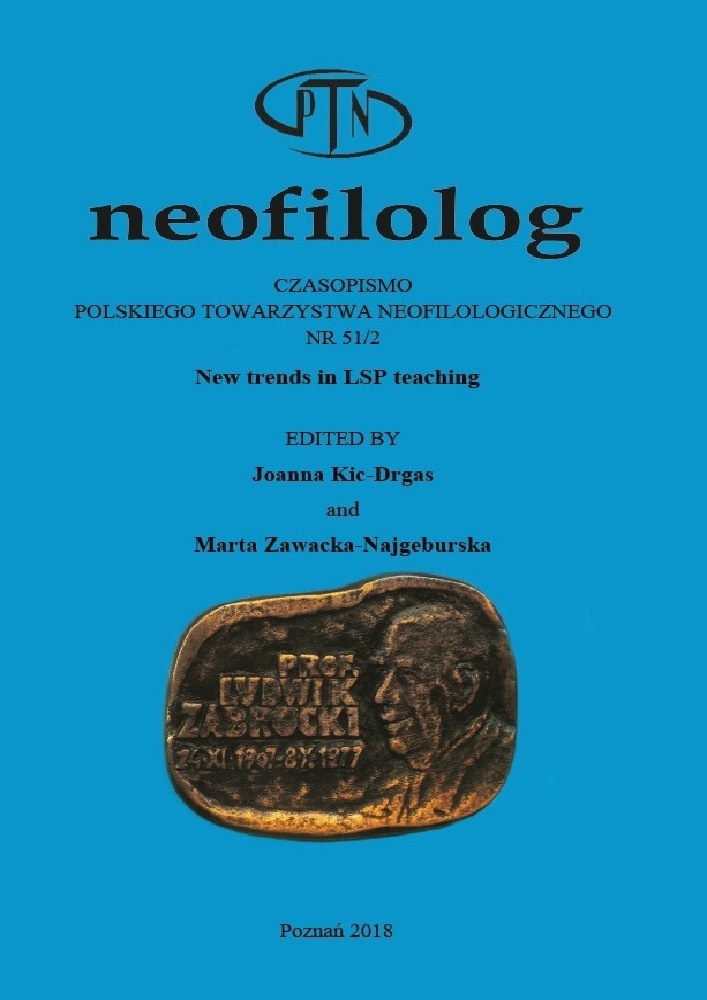Abstract
In the following paper the author presents selected theories and approaches related to the translation of songs. She believes that these are crucial in understanding the melic translation process. Some aspects of the melic translation process itself, especially those connected with the translator’s decision, are also mentioned. They are described in order to show the need for an interdisciplinary perspective when approaching the topic. The main aim of the article is to present a possible solution for song translation with reference to the theories presented. The solution proposed involves the need to keep in mind not only ‘the message’ of the song, semantic dominant, harmonic dominant, and ‘the sound’ but also the fact that children are the main recipients.
References
Baluch J. (ed.) (2006), Przekład literatury dziecięcej. “Przekładaniec”, No 16, pp. 41-56.
Baluch J. (ed.) (2004), Z teorii i historii przekładu artystycznego. Kraków: Uniwersytet Jagielloński.
Barańczak S. (2004), Ocalone w tłumaczeniu. Szkice o warsztacie tłumacza poezji z dodatkiem małej antologii przekładów i problemów. Kraków: Wydawnictwo AP.
Barańczak S. (1974), Przekład artystyczny jako “samoistny” i “związany” obiekt interpretacji (in) Baluch J. (ed.), Z teorii i historii przekładu artystycznego. Kraków: Uniwersytet Jagielloński, pp. 47-74.
Barańczak S. (1992), Rice pudding i kasza manna. Ocalone w tłumaczeniu. Poznań: Wydawnictwo a5.
Bednarczyk A. (1993), Przekład poezji śpiewanej a odtworzenie w nim warstwy muzycznej oryginału (in) Semczuk A., Zwarzer W. (eds), Literatura i słowo wczoraj i dziś. Piśmiennictwo rosyjskie a państwo totalitarne, Materiały konferencji naukowych (10-11 czerwca). Warszawa: Instytut Rusycystyki Uniwersytetu Warszawskiego, pp. 135-141.
Bednarczyk A. (2005), Murka warianty intra- i interlingwalne. (Jeszcze raz o tłumaczeniu piosenki) (in) Fast P. (ed.), Kultura popularna a przekład. Katowice: Wydawnictwo Naukowe „Śląsk”, pp. 123-139.
Bednarczyk A. (1995), Wysocki po polsku. Problematyka przekładu poezji śpiewanej. Łódź: Wydawnictwo Naukowe UŁ.
Bristiger M. (1986), Związki muzyki ze słowem. Z zagadnień analizy muzycznej. Warszawa: Polskie Wydawnictwo Muzyczne.
Bryll A. (2006), Zyski i straty w filologicznych i melicznych przekładach piosenek Stinga (in) Fast P., Janikowski P. (eds), Dialog czy nieporozumienie? Z zagadnień krytyki przekładu. Katowice: “Śląsk”.
Bryll A. (2012), Semantic dominant feature in melic (over?) translation of song (in) Bryll A., Sikora I. M., Walczyński M. (eds), Philological Inquiries. Nysa: Publishing Office PWSZ Nysa, pp. 85-100.
Burzyńska A., Markowski M. P. (2007), Teorie literatury XX wieku. Podręcznik, Kraków: Wydawnictwo ZNAK.
Christiansen B. (1914), Filozofia sztuki. Warszawa: Warszawa: Księgarnia F. Hoesicka.
Jakobson R., Tynianow J. (1978), Problemy badań nad literaturą i językiem, translated by E. Korpała-Kirszak (in) Tynianow J. (ed.), Fakt literacki. Warszawa.: Wydawnictwo P.I.W, pp. 5-11.
Kolago L. (1997), Musikalische formen und Strukturen in der deutschsprachigen Literatur des 20. Jahrhunderts. Salzburg: Verlag Muller-Speiser.
Krysztofiak M. (2011), Translatologiczna teoria i pragmatyka przekładu artystycznego. Poznań: Wydawnictwo Naukowe UAM.
Osadnik W. (2006). »Ja«, »ty«, »my«, »wy« pogubione w polskim przekładzie utworów Leonarda Cohena (in) Fast P., Osadnik W. (eds), Przekład jako komunikat. Katowice: Wydawnictwo Naukowe „Śląsk”, pp. 135-149.
Osadnik W., Nowinka A. (2006a), The Problem of Equivalence in Translation of Songs (in) Fast P., Osadnik W. (eds), Przekład jako komunikat. Katowice: Wydawnictwo Naukowe „Śląsk”, pp. 103-115.
Puurtinen, T. (1995), Linguistic Acceptability in Translated Children’s Literature. Joensuu: University of Joensuu.
Piaget J., Inhelder B. (1956), The Child’s Conception of Space. London: Routlege and Kegan Paul.
Tomaszewski M. (2003), Muzyka w dialogu ze słowem. Kraków: Akademia Muzyczna.
Zagórski J. (1995), Tłumaczenie oper i sztuk pisanych wierszem. O sztuce tłumaczenia. Wrocław: Zakład im. Ossolińskich.
Zazula P. (1999), Dominanta dramatyczna w przekładach tekstów piosenek (in) Dąbska-Prokop U. (ed.), Przekład literacki a przekład użytkowy. Teoria i praktyka. Częstochowa: Educator, pp. 100-116.
License
Copyright (c) 2018 Neofilolog

This work is licensed under a Creative Commons Attribution-NoDerivatives 4.0 International License.
Authors
Authors of texts accepted for publication in Neofilolog are required to complete, sign and return to the Editorial team’s office the Agreement for granting a royalty-free license to works with a commitment to grant a CC sub-license.
Under the agreement, the authors of the texts published in Neofilolog grant Adam Mickiewicz University in Poznań a non-exclusive, royalty-free license and authorize the use of Attribution-NoDerivatives 4.0 International (CC BY-ND 4.0) Creative Commons sub-license.
The authors retain the right to the free disposal of the work.
Users
Interested Internet users are entitled to use works that have been published in Neofilolog since 2017, under the following conditions:
▪ attribution – obligation to provide, together with the distributed work, information about the authorship, title, source (link to the original work, DOI) and the license itself.
▪ no derivatives – the work must be preserved in its original form. Without the author's consent, it is not possible to distribute the modified work in the form of translations, publications, etc.
Copyrights are reserved for all texts published since 2017.
Miscellaneous
Adam Mickiewicz University in Poznań retains the property right as a whole (layout, graphic form, title, cover design, logo etc.).

